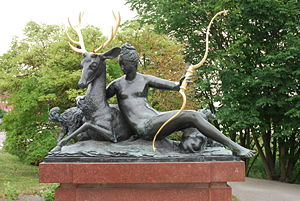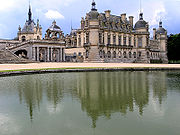
Henry II style
Encyclopedia

France
The French Republic , The French Republic , The French Republic , (commonly known as France , is a unitary semi-presidential republic in Western Europe with several overseas territories and islands located on other continents and in the Indian, Pacific, and Atlantic oceans. Metropolitan France...
, part of Northern Mannerism
Northern Mannerism
Northern Mannerism is the term in European art history for the versions of Mannerism practiced in the visual arts north of the Alps in the 16th and early 17th century...
. It came immediately after High Renaissance
High Renaissance
The expression High Renaissance, in art history, is a periodizing convention used to denote the apogee of the visual arts in the Italian Renaissance...
and was largely the product of Italian influences. Francis I
Francis I of France
Francis I was King of France from 1515 until his death. During his reign, huge cultural changes took place in France and he has been called France's original Renaissance monarch...
and his daughter-in-law, Catherine de' Medici
Catherine de' Medici
Catherine de' Medici was an Italian noblewoman who was Queen consort of France from 1547 until 1559, as the wife of King Henry II of France....
, had imported to France a number Italian artists of Raphael's
Raphael
Raffaello Sanzio da Urbino , better known simply as Raphael, was an Italian painter and architect of the High Renaissance. His work is admired for its clarity of form and ease of composition and for its visual achievement of the Neoplatonic ideal of human grandeur...
or Michelangelo's
Michelangelo
Michelangelo di Lodovico Buonarroti Simoni , commonly known as Michelangelo, was an Italian Renaissance painter, sculptor, architect, poet, and engineer who exerted an unparalleled influence on the development of Western art...
school; the Frenchmen who followed them in working in the Mannerist idiom. Besides the work of Italians in France, many Frenchman picked up Italianisms while studying art in Italy during the middle of the century. The Henry II style, though named after Henry II of France
Henry II of France
Henry II was King of France from 31 March 1547 until his death in 1559.-Early years:Henry was born in the royal Château de Saint-Germain-en-Laye, near Paris, the son of Francis I and Claude, Duchess of Brittany .His father was captured at the Battle of Pavia in 1525 by his sworn enemy,...
, in fact lasted from about 1530 until 1590 under five French monarchs, their mistresses and their queens.
The most lasting products of the Henry II style were architectural. First Rosso Fiorentino
Rosso Fiorentino
Giovanni Battista di Jacopo , known as Rosso Fiorentino , or Il Rosso, was an Italian Mannerist painter, in oil and fresco, belonging to the Florentine school.-Biography:...
and then Francesco Primaticcio
Francesco Primaticcio
Francesco Primaticcio was an Italian Mannerist painter, architect and sculptor who spent most of his career in France.-Biography:...
and Sebastiano Serlio
Sebastiano Serlio
Sebastiano Serlio was an Italian Mannerist architect, who was part of the Italian team building the Palace of Fontainebleau...
served Henry II as court artisans, constructing his gallery and the Aile de la Belle Cheminée (1568). The French architect Pierre Lescot
Pierre Lescot
Pierre Lescot was a French architect active during the French Renaissance, "the man who was first responsible for the implantation of pure and correct classical architecture in France." He was born in Paris....
and the sculptor Jean Goujon
Jean Goujon
Jean Goujon was a French Renaissance sculptor and architect.-Biography:His early life is little known; he was likely born in Normandy and may have traveled in Italy...
rebuilt the Palais du Louvre
Palais du Louvre
The Louvre Palace , on the Right Bank of the Seine in Paris, is a former royal palace situated between the Tuileries Gardens and the church of Saint-Germain l'Auxerrois...
around the now famous square court. The Château d'Anet
Château d'Anet
The Château d'Anet is a château near Dreux, France, built by Philibert de l'Orme from 1547 to 1552 for Diane de Poitiers, the mistress of Henry II of France...
, commissioned by Diane de Poitiers
Diane de Poitiers
Diane de Poitiers was a French noblewoman and a prominent courtier at the courts of kings Francis I and his son, Henry II of France. She became notorious as the latter's favourite mistress...
, mistress of Henry II, was designed by Philibert Delorme, who studied in Rome
Rome
Rome is the capital of Italy and the country's largest and most populated city and comune, with over 2.7 million residents in . The city is located in the central-western portion of the Italian Peninsula, on the Tiber River within the Lazio region of Italy.Rome's history spans two and a half...
. The very mannerist château housed a statue of Diana by Benvenuto Cellini
Benvenuto Cellini
Benvenuto Cellini was an Italian goldsmith, sculptor, painter, soldier and musician, who also wrote a famous autobiography. He was one of the most important artists of Mannerism.-Youth:...
, who was working in France. In 1564 Delorme began work on the Tuileries, the most outstanding Parisian palais of the Henry II style. It too exhibited a mannerist treatment of classical themes, for which Delorm had developed his own "French order" of columns.

Jean Bullant
Jean Bullant was a French architect and sculptor who built the tombs of Anne de Montmorency, Grand Connétable of France, Henri II, and Catherine de' Medici. He also worked on the Tuileries, the Louvre, and the Château d'Écouen...
, another architect who studied in Rome, also produced designs that combined classical "themes" in a mannerist structure. The Château d'Écouen
Château d'Écouen
The Château d'Écouen is a historical building in Écouen, north of Paris, France. It was built in 1538–1550 for Anne de Montmorency, who was made connétable in 1538. He had inherited the château in 1515, and his building campaigns were informed by his first-hand experience in overseeing royal works...
and the Château de Chantilly
Château de Chantilly
The Château de Chantilly is a historic château located in the town of Chantilly, France. It comprises two attached buildings; the Grand Château, destroyed during the French Revolution and rebuilt in the 1870s, and the Petit Château which was built around 1560 for Anne de Montmorency...
, both for Anne de Montmorency
Anne de Montmorency
Anne de Montmorency, duc de Montmorency, Honorary Knight of the Garter was a French soldier, statesman and diplomat. He became Marshal of France and Constable of France.-Early life:...
, exemplify the Henry II-style château, which was proliferating among the nobility. A very thorough catalogue of engravings of sixteenth-century French architecture was produced by Jacques Androuet du Cerceau the Elder under the title Les plus excellents bastiments de France (between 1576 and 1579, in two volumes). Much of the buildings so engraved have been destroyed (like the Tuileries) or significantly altered (like Écouen), so that Cerceau's reproductions are the best guide to the Henry II style.

School of Fontainebleau
The Ecole de Fontainebleau refers to two periods of artistic production in France during the late Renaissance centered around the royal Château de Fontainebleau, that were crucial in forming the French version of Northern Mannerism....
, which in turn produced an active and talented crop of native painters and sculptors, such as Germain Pilon
Germain Pilon
Germain Pilon was a French Renaissance sculptor.-Biography:He was born in Paris. Trained by his father and Pierre Bontemps, Pilon was an expert with marble, bronze, wood and terra cotta; from about 1555 he was providing models for Parisian goldsmiths...
and Juste de Juste
Juste de Juste
Juste de Juste was a Franco-Italian sculptor and printmaker in etching, a member of the Betti family of sculptors from near Florence, who became known as the Juste family in France, where Juste de Juste's father Antonio and his two brothers emigrated and spent most of their careers...
. By the end of the century the Henry II style, a Gallicised form of Italian mannerism, had been replaced by a more consistent classicism, with hints of the coming Baroque
Baroque
The Baroque is a period and the style that used exaggerated motion and clear, easily interpreted detail to produce drama, tension, exuberance, and grandeur in sculpture, painting, literature, dance, and music...
. Its immediately successor in French art historiography is the Henry IV style
Henry IV style
The Henry IV style was the predominant architectural idiom in France under the patronage of Henry IV . The modernisation of Paris was a major concern of Henry's, and the Place des Vosges is the greatest monument to his architectural style and urban planning...
.

